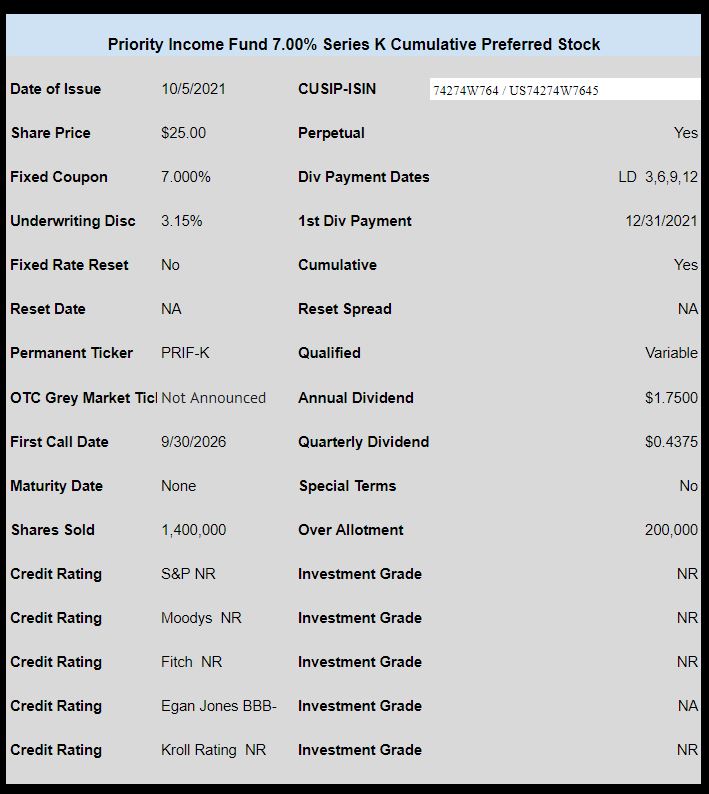OTC ticker is PRIFP
Non publicly traded CEF Priority Income Fund has priced their 1st issue of perpetual preferred stock. Historically the fund has only issued ‘term’ preferred stock (stock with a redemption date).
The issue prices with a coupon of 7.00% for 1.4 million shares with another 200,000 reserved for over allotment. The issue is rated BBB- by Egan-Jones.
The coupon for this new perpetual preferred stock is 1% above that which the company could have garnered with a term preferred. Obviously the perpetual nature of this new issue is a feature Priority Income desires–it allows the company to get out of the continuous cycle of issue, redeem and then re-issue. Each time the company goes through this cycle they spend substantial money on the issuance costs of the new issue (3.15% on just the underwriter discount).
All of Priority Income Fund’s outstanding issues can be found here.
The new issue will trade under permanent ticker PRIF-K when it reaches the ultimate stock exchange. The OTC ticker has not been announced.

The pricing term sheet can be read here.

Trading as PRIFP at vanguard. $24.50
FWIW, I kinda like the “term” aspect of their term preferreds, especially given that it’s a non publicly traded fund that principally holds CLOs. I don’t think the +/- 1% increase in coupon is enough to tempt me to go the perpetual preferred route. Long PRIF-H
DCO: Not redeemable by you.. nothing automatic. UNLESS it goes on a long time and the managers get sued to meet their obligations which they have NOT remedied.
Some times the market goes back up , and thus NAV mark to market goes up too, so it remedies itself.
If critical, typically the management has to “remedy” the situation usually by selling equity and other maneuvers to add to NAV.
Others here (TIM!) may have a more complete view of this process, but that is about as far as my legal-beagle brain can take me on this.
Could someone please explain what should be “reserved for over allotment” and how should I take this into consideration when making my analysis?
The amount the company and underwriters can agree to sell AFTER the initial committed number of shares are bought out. Usually depends on how the market accepted the initial ‘clot’ of new shares.
No real consideration, altho I have let open order to buy just stand there and gotten filled at my price IF there is an overallotment sale afterwards.
Appreciate the explanation. I would like to ask you is it necessary these “allotment shares” to be sold on the market right after the initial committed number of shares or it can take some time? Actually, do they announce somewhere if this additional shares will be placed on the market or not?
Riskfree–typically they make them available for 30 days and likely they only announce after the fact.
And isn’t it almost always a one way bet taken by the underwriters after the fact? There’s no obligation for these shares to be issued, so the underwriters only exercise the over allotment after they know for sure they’ve priced the deal right and they can sell the additional shares easily… More frequently than not, I think the allotment shares end up being issued as a non-event – at least in this market.
Would I be correct in assuming non publicly traded funds have to meet the same coverage criteria as the publicly traded funds?
Jerseyvinny–yes they do. And in the case of Priority they are running around 280%.
So this should be redeemable if they fall below 200%, just like the others?
DCO— yes, but there are multiple ways to ‘skin this cat’. If the coverage was falling they would likely try to sell as much equity as possible to raise the coverage. They could buy back any of the preferred issues to raise the coverage. Here is an old (nore than 10 years ago) article I wrote on Seeking Alpha a long time ago–ignore the title (seeking alpha editors put it on there).
https://seekingalpha.com/article/265958-preferred-shares-of-these-4-cefs-for-a-conservative-outlook
Thanks, Tim. Good to know what their response would be in that situation. I appreciate everything you do here.